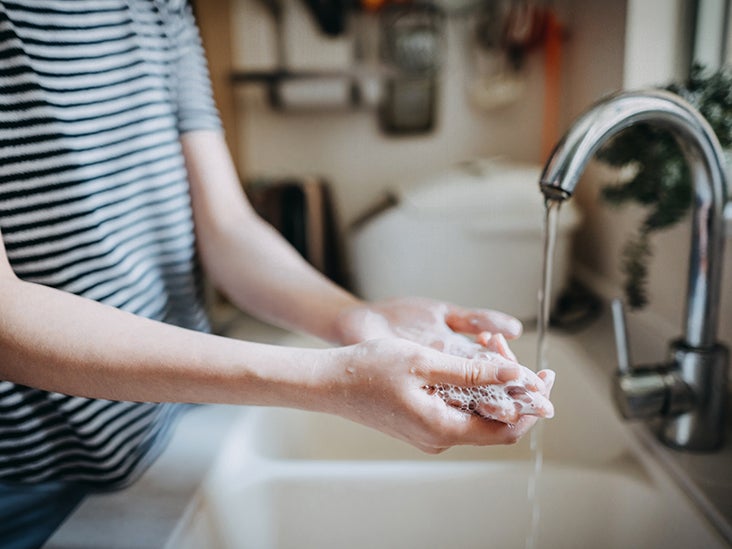Dyshidrotic eczema: What to know about summer finger bumps - Medical News Today

Dyshidrotic eczema is a type of eczema that produces skin blisters on the feet and hands. Many people call these small blisters summer finger bumps.
People may also refer to dyshidrotic eczema as dyshidrosis, pompholyx, foot-and-hand eczema, vesicular eczema, or palmoplantar eczema.
The blisters or bumps that form can be uncomfortable and painful, but they are not permanent.
Dyshidrotic eczema involves flare-ups that last several weeks.
Below, we look at the symptoms, causes, risk factors, and treatment options for dyshidrotic eczema, as well as how diet may impact this condition.
Doctors sometimes call dyshidrotic eczema "pompholyx eczema."
Pompholyx is the word for "bubble" in Ancient Greek. The condition produces painful, itchy blisters on the hands and feet. Water-filled blisters can appear on the fingers, palms of the hands, soles of the feet, and toes.
People with this type of eczema may also have other types of eczema elsewhere on the body.
Dyshidrotic eczema may occur as a one-time episode. However, it often occurs as a chronic condition that involves repeated flare-ups.
Symptoms of dyshidrotic eczema include:
- extreme itching
- burning sensation
- a sensation of heat in the palms or soles
- prickling sensation
- the sudden appearance of small blisters, often on the sides of the fingers
- painful drying and cracking of the skin
- swelling and changes to the skin around the nail
The blisters start small and then grow bigger. They may weep fluid and produce discoloration. They do not appear in other places on the body.
If someone has small, water-filled blisters elsewhere, it may be another form of eczema or another skin condition.
The bumpy blisters on the sides of fingers may develop as a result of excessive sweating or heat exposure. People sometimes refer to them as summer finger bumps.
There is no definitive known cause for dyshidrotic eczema. However, some things are likely to trigger flare-ups, including:
- stress
- metal allergies or sensitivities, such as nickel allergy
- other types of allergies, such as seasonal allergies
- sweating
- hot, humid weather
According to the National Eczema Society, half of those with dyshidrotic eczema also have atopic eczema or a family history of the skin condition.
Dyshidrotic eczema is more common in people under 40 years of age. It is also more common in females.
According to the American Academy of Dermatology, other risk factors include:
- having another type of eczema
- having seasonal allergies or asthma
- having an allergy to certain metals
- having feet or hands that frequently sweat or become wet
- having a family history of dyshidrotic eczema
- working with metals
- being a mechanic
- working with cement
A person with symptoms of dyshidrotic eczema should see a doctor or dermatologist for a diagnosis.
A doctor will examine the skin and take a medical and family history to come up with a diagnosis and treatment plan.
A doctor may also recommend allergy testing to check for specific triggers that may be exacerbating the eczema.
There is no cure for dyshidrotic eczema. However, there are ways to manage the condition. A doctor may prescribe:
- medical moisturizer
- wet soaking with potassium permanganate to help with oozing blisters
- topical steroids to reduce inflammation
- oral antibiotics to combat bacterial infection
- oral immunosuppressant drugs
- phototherapy
Note that steroids are not a long-term treatment solution. People should not use them for longer than 2-week periods.
Dealing with a flare-up of dyshidrotic eczema can be difficult. The condition is often painful and bothersome.
The National Eczema Society suggest some strategies for at-home relief, including:
- washing with lukewarm water
- using an emollient instead of soap to prevent irritation
- avoiding direct contact with skin-irritating ingredients or products
- taking antihistamines with a sedative effect to help with itching and sleep
- draining large, painful blisters with a sterile needle
- bandaging the skin after applying creams or ointments
Stress management can also help prevent flare-ups.
Dietary triggers may contribute to flare-ups for some people. Avoiding these foods may help prevent symptoms.
As a nickel allergy may cause dyshidrotic eczema, it is possible that avoiding foods high in nickel
- canned meats
- black tea
- beans
- chocolate
- peas
- lentils
- nuts
- seeds
- shellfish
- soybeans
Learn more about elimination diets for eczema here.
An infection may develop as the blisters grow larger and start to secrete fluid.
Some people may also have fungal infections at the same time as they experience dyshidrotic eczema flare-ups.
If someone with dyshidrotic eczema develops a skin infection, they should talk with a doctor. An infection may require antibiotic treatment.
Some symptoms of a skin infection include:
- discoloration
- swelling
- oozing pus
Preventing flare-ups involves avoiding known triggers such as allergens or temperature changes. Other strategies for preventing dyshidrotic eczema and its painful symptoms include:
- applying moisturizer to prevent dryness and cracking
- wearing loose, breathable clothing
- humidifying the air to prevent skin dryness
It can be challenging to live with dyshidrotic eczema because it affects the hands and feet.
Some people with the condition may not be able to work during flare-ups. They may also have trouble walking if they develop painful blisters on their feet.
However, it is possible to manage this type of eczema. People with dyshidrotic eczema should talk with a doctor to find an appropriate treatment option.
Dyshidrotic eczema can cause small fluid-filled bumps or blisters to appear on the feet, hands, or other areas of the body.
Various factors can trigger a flare-up of dyshidrotic eczema. These include dietary and environmental allergens, stress, weather conditions, and sweat.
A doctor can help people with dyshidrotic eczema find an appropriate treatment option.
A combination of treatment and prevention strategies can help a person manage the painful symptoms of dyshidrotic eczema.
Read this article in Spanish.
Comments
Post a Comment